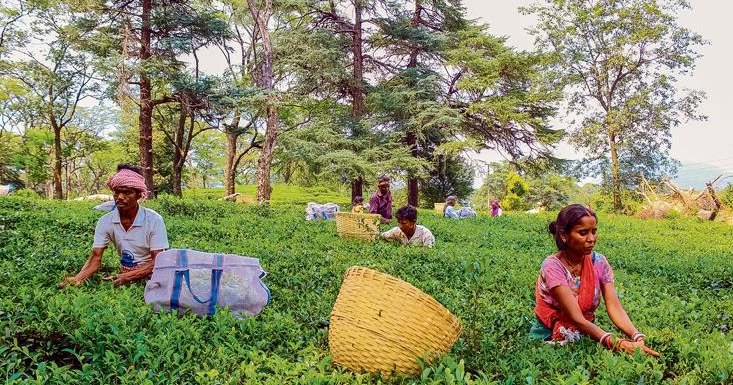Kangra Tea : Heralding Tea Tourism In The North

By Colonel Satish Singh Lalotra
‘Tea is the magic key to the vault, where my brain is kept’—-Frances Hardinge
For centuries India’s frontiers guarded by the physical barriers in the form of mountains, deserts and the seas have buffeted this country from the vagaries of onslaught of time and tide; in the bargain saving some of the mysteries that are still being unraveled with the passage of time. There are many places in this country which are slowly revealing their USP that lay hidden for decades to no end. Kangra tucked away in the far north of India in the snowy expanse of the Dhauladhar ranges of Himachal Pradesh perfectly qualify one such location that has the potential to rivet worldwide attention.
This potential of Kangra lies not only in its physical beauty of mountains, lakes, forested regions and ancient forts but in an altogether different area—its unique product going by the name of ‘Kangra tea’. The Himalayas have been the source of purity, rejuvenation, and many more. They have been home to many people, as also to many lesser known facts; one of which has been the tasty leaves of Kangra tea. Surprisingly Kangra produces one of the finest varieties of black and green teas this side of Suez Canal. What comes to your mind when someone says the valley of pristine tea leaves? The rich and pure fresh tea gardens of Kangra off course.
Tea reminds of things we seek: peace, warmth, and vitality, as well as the distant hills that create them. Be that as it may, it is an altogether different ball game when it comes to experiencing the tea in its entirety beginning its wonderful journey from a tea garden. Sipping and soaking the tea flavour in the cozy comfit of our drawing rooms is just no match to the actuality of these tea gardens when roamed around with a notion of catching its essence that goes into making it a rich brew. All this is feasible with a single stroke—‘Tea tourism’ to be precise.
Now what exactly is this ‘Tea tourism’ and what all does it entail? Is this a new concept or is it again the proverbial ‘Old wine in a new bottle? Tourism as we all understand is the typical travel and the commercial activity of providing and supporting such travel. UN Tourism (UNWTO until 2023) a specialized agency of the UN defines tourism more generally, in terms which go ‘beyond the common perception of tourism as being limited to holiday activity only’. It further says ‘travelling and staying in places outside their usual environment for not more than one consecutive year for leisure and not less than 24 hours, business and other purposes. Tourism per se develops cross linkages with other sectors of human activities too which includes local development of the area, economic up lifting as well as raising the standards of the people in general; off course not missing the filling of state and national exchequer with the much needed money for other developmental activities of the country.
Tea tourism’ is just like any other part of tourism, albeit with ‘Tea’ acting as a sine quo non in this whole business and forming as the bedrock for attracting the tourists. It has the potential to completely transform the tea-drinking experience by assisting us in totality the origins, processing, packaging, marketing and terroir of tea. It has sensory appeal; we can feel the dew kissed tea leaves and smell the earthiness of the soil where it grows. In a country as diverse as India, there are several versions and names for a cup of tea in every corner, and the best way to explore the same is to visit one of such tea garden and explore the complete journey of a tea leaf from a tea bush right up to your cup of tea. Many of us may exclaim that it is not my cup of tea. But then why create a storm in a tea cup, and not just hop on the nearest conveyance, visit the nearest tea facility and be done with it. It is just that simple.
Life’s journey full of twists and turns as well as rough and tumble can only turn heady if supplied with copious amounts of elixir. What better elixir to kick start your day than a steaming hot cup of tea with its aroma wafting into your nostrils awakening your very being to take on the highs and lows of the day with gusto. The three main regions where tea has held its sway without any challenge in India are mainly found in Assam, Darjeeling and the Nilgiri hills of south India. The largest tea plant variety ‘Camellia Sinensis Assami’ was discovered by an English explorer cum botanist in 1815 going by the name ‘Robert Bruce’. By 1870, the British had started to establish machinery to help speed up tea production process with less labour. Tea tourism in India has become increasingly popular in recent years. Travellers seek to experience the rich history, culture, and natural beauty of the country’s tea growing regions. Being one of the largest tea producing countries of the world, India has now belatedly woken up to this concept of sleeping giant going by the name – tea tourism.
As stated above, tea tourism though a relatively new concept to attract the attention of masses, involve visiting tea estates, learning about the tea production process, and sampling different varieties of tea. With the concept of tea tourism gaining traction in the last few years many tea estates offer guided tours, where travellers can see the tea plucking, processing, and packaging simultaneously. Some tea estates also offer activities such as tea-tasting, tea making workshops, and nature walks through these tea gardens. Tea tourism has the potential to contribute to domestic tourism industry by attracting tourists from all over the world to some of these finest tea gardens.
The tea growing regions of India are located in some of the most scenic and culturally rich parts of the country. The region of Kangra in Himachal Pradesh boasts of a very rich tapestry of history, art, culture, painting, forts and martial traditions. Who can forget ‘Porus the warrior king who had the gumption of crossing swords with Alexander the great in the famous battle of Hydaspes in May 326 BC and nearly defeating him? The former was one of the descendants of the famous and also oldest ‘Trigarta kingdom’ that had its lineage going back to the Mahabharta days; and belonged to Kangra region. Kangra also boasts of world famous ‘Kangra paintings’ which are a variety of Pahari miniature paintings.
All these USPs of Kangra when dovetailed with that of the concept obtaining out of tea tourism can be a heady cocktail for a traveler to savour at leisure. In the same year of Kangra’s accession to British India in 1849, the British botanists conducted a survey of Kangra valley to see what could possibly be grown there commercially. And were pleasantly surprised that the climate did hold good for mass cultivation of tea. Accordingly ‘China tea trees’ ( SinensisSinesis) were brought in from the nurseries in the United provinces ( present day Utrakhand) and planted at four locations in the Kangra valley. Now these plants thrive at Palampur & Dharamshala as part of Kangra valley.
As if the above is not enough to give a heft to this unique tea of Himalayas, it has been now a proven scientific fact that this Kangra tea has within its leaves medicinal wonders waiting to be unleashed on a massive scale for the consumption of the masses. It has been a proven fact that chemicals in the Kangra tea act as an effective catalyst in boosting the immunity and can block corona virus activity better than anti-HIV drugs. Not only Kangra boasts of so called tea tourism, but it also has a substantial foot print in terms of ‘Wellness tourism’ that has spread far and wide in this part of ‘Dhaula Dhar ranges’ of Himachal Pradesh. There are dime a dozen yoga and meditation centers in and around Kangra, Dharamshalsa etc which boasts of a solid wellness tourism taking its shape which when combined with the new concept of tea tourism can simply bowl over a tourist to no end.
Tea tourism is a unique experience that requires an in-depth knowledge of the local culture, traditions, and tea industry. By presenting tea tourism as a more immersive and experiential activity in and around Kangra region it is hoped to pique the interest of travellers to this northern most part of India. I have had the unique opportunity to visit these tea gardens of Kangra and Dharamshala way back in 2004/05 while posted in Jammu and Kashmir, but that time this novel concept of tea tourism had not really taken off with all its USPs. With the ‘Gaggal’ airport to Kangra town just 10 kms in distance, the last mile connectivity by air to the vast tea gardens of Kangra could provide a much needed booster shot to an international traveller who may not think twice to loosen his or her purse strings for more comfort and ease of travel. Need is to expand the canvas of this tea tourism in its entirety and encompass the masses of the area to partake in the fruits of development that were till now in a state of suspended animation.
(The writer is a retired army officer an can be approached on his email—slalotra 4729@gmail.com)



